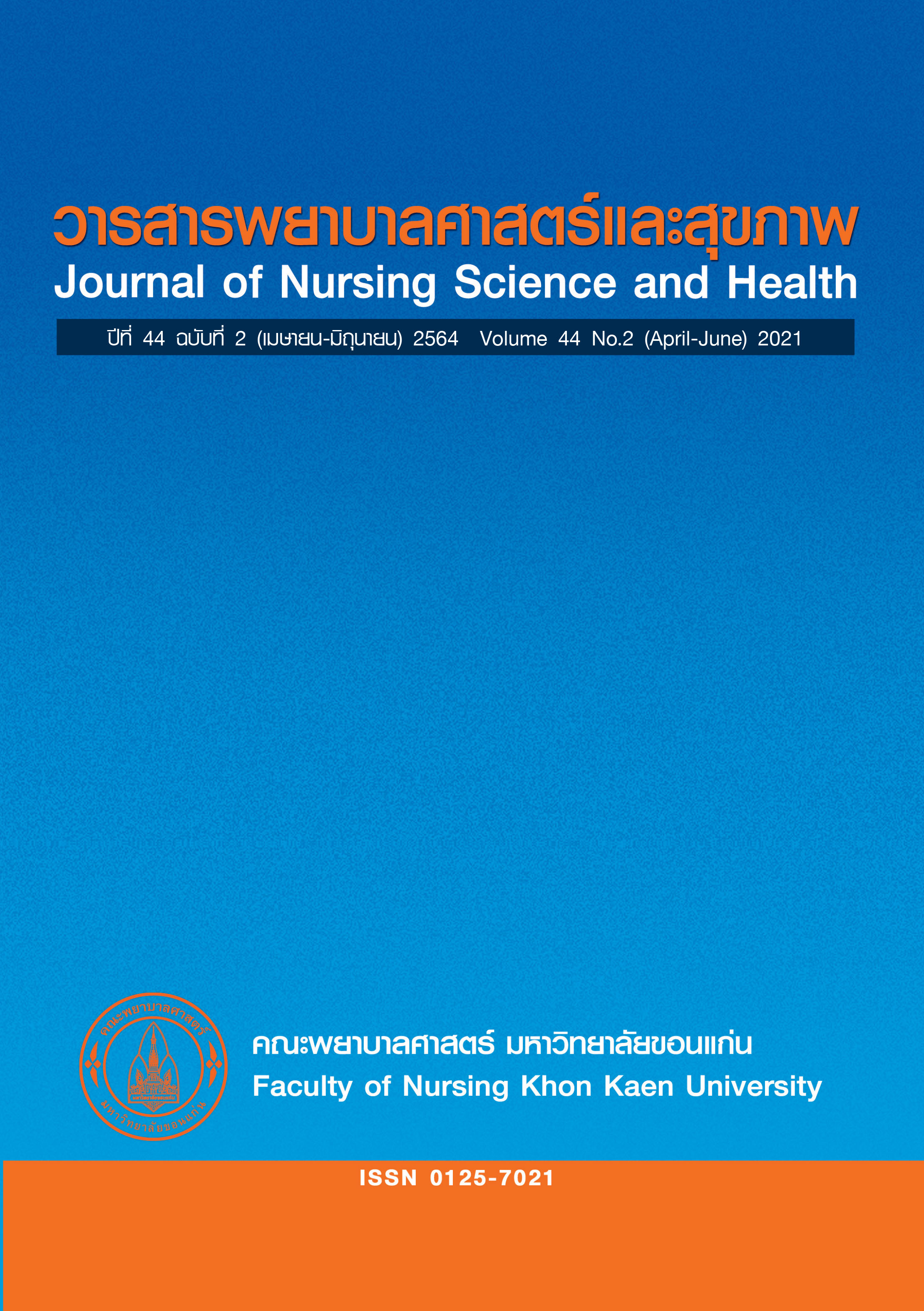ปัจจัยที่มีความสัมพันธ์กับความเครียดของนักศึกษาพยาบาล
คำสำคัญ:
ความเครียด, นักศึกษาพยาบาลบทคัดย่อ
การศึกษาครั้งนี้เป็นการวิจัยเชิงเชิงพรรณนา (Descriptive research) เพื่อศึกษาความเครียดและปัจจัยที่มีความสัมพันธ์กับความเครียดของนักศึกษาพยาบาล กลุ่มตัวอย่างเป็นนักศึกษาพยาบาลชั้นปีที่ 1 วิทยาลัยพยาบาลบรมราชชนนี ชลบุรี จำนวน 111 คน เครื่องมือที่ใช้ในการเก็บรวบรวมข้อมูล คือ แบบสอบถามปัจจัยภายในส่วนบุคคล แบบสอบถามเจตคติต่อวิชาชีพ แบบสอบถามปัจจัยภายนอกที่มีความสัมพันธ์กับความเครียด และแบบวัดความเครียดสวนปรุง เครื่องมือที่ใช้ในงานวิจัยนี้ได้ผ่านการตรวจสอบคุณภาพของเครื่องมือจากผู้ทรงคุณวุฒิ 3 ท่าน และ ตรวจสอบค่าความเชื่อมั่นโดยใช้สูตรสัมประสิทธิ์แอลฟ่าครอนบาค เท่ากับ .90, .90, .85, และ .95 ตามลำดับ นำข้อมูลที่ได้มาวิเคราะห์ โดยคำนวณหาความถี่ ร้อยละ ค่าเฉลี่ย ส่วนเบี่ยงเบนมาตรฐาน และค่าสัมประสิทธิ์สหสัมพันธ์ของเพียร์สัน
ผลการวิจัยพบว่า นักศึกษาพยาบาลส่วนใหญ่มีความเครียดในระดับสูง (ร้อยละ 39.64) รองลงมามีความเครียดในระดับปานกลาง (ร้อยละ 38.74) ส่วนปัจจัยที่มีความสัมพันธ์กับความเครียด พบว่า ปัจจัยภายในส่วนบุคคล มีความสัมพันธ์กับความเครียดอย่างมีนัยสำคัญทางสถิติที่ระดับ .05 เจตคติต่อวิชาชีพ ความสัมพันธ์กับบุคคลอื่น และที่อยู่อาศัย มีความสัมพันธ์กับความเครียดอย่างมีนัยสำคัญทางสถิติที่ระดับ .01 ดังนั้นควรส่งเสริมให้นักศึกษาพยาบาลมีเจตคติที่ดีต่อวิชาชีพการพยาบาล รวมทั้งจัดกิจกรรมที่ส่งเสริมความสัมพันธ์ระหว่างนักศึกษาพยาบาล และอาจารย์ให้มีสัมพันธภาพไปในทิศทางที่ดีและเหมาะสม และควรมีการพัฒนาโปรแกรมการจัดการความเครียดที่สอดคล้องกับสภาพปัญหา ศึกษาผลของโปรแกรม ติดตามผลในระยะยาว เพื่อให้นักศึกษาพยาบาลมีระดับความเครียดที่ลดลงและใช้ชีวิตในสถาบันการศึกษาอย่างมีความสุข
เอกสารอ้างอิง
Department of mental health, Ministry of public health. Handbook of relax stress (New revised edition). Bangkok: The war veterans’ organization; 2012. (in Thai)
Lazarus R, Folkman S. Stress appraisal and coping. New York: Springer; 1984.
Department of mental health, Ministry of public health. Ministry of public health to reveal “Stress problem” the reigning consult hot line 1323 champion in 2017, worker use 10 ways to reduce stress[Website]; 2018. Available from: http://www.prdmh.com. (in Thai)
Sihawong S, Nitchakarn P, Natthida Y, Natnaree N, Nattamon A, Thumporn B, et al. Factors causing to stress of nursing students, Ubonratchatani University. HCU Journal of Health Science 2018;21(42):93-106. (in Thai)
Chaleoykitti S, Chewsothon S, Butpunya Y. Effectiveness of the integrated academic service and teaching- learning arrangement in psychiatric nursing practicum course to psychiatric nursing practice competency in army nurse. Journal of The Royal Thai Army Nurses 2017; 18(3):144-52. (in Thai)
Boonpume N. Stress and coping of Thai traditional medicine students of Rajamangala university of Technology Thanyburi. Thesis for the Master of Sciences degree, Silpakorn University; 2010. (in Thai)
Khan HUD, Gulzar S, Yahya F. Crucial factors affecting stress: A study among undergraduates in Pakistan. International Journal of Asian Social Science 2013; 3(2): 248-442.
Chantarasena T. Stress of freshmen at Srinakarinwirotuniversity. Thesis for the master of education degree in higher education, Srinakharinwirot University; 2012. (in Thai)
Kentya FC, Busuyi OS, Andrew TV, Rochelle R, Patrick D. Factors contributing to perceived stress among doctor of pharmacy (PharmD) students. College Student Journal 2014; 48(2):189-98.
Intaraprawat C. From student to profession. Nakhonratchasima: Student Affairs Suranaree University of Technology; 2015. (in Thai)
Lekuthai S, Chuto J, Sirisuntorn W. The study of the relationship between factors affecting stress and stress in first year nursing students, Faculty of Nursing Ratchathani University. National academic conference and research presentation 1st academic year, 29 July 2016. Ubonratchathani: Faculty of Nursing Ratchathani University; 2016. (n Thai)
Chaiwong N. Stress and sources of stress among nursing student at faculty of nursing Buriram, Western University. The 10th National symposium and research presentation [Website]; 2018. Available from: http://www.western.ac.th/media/attachments/2018/
Sharma N, Kaur A. Factors associated with stress among nursing students. Nursing and Midwifery Research Journal 2011;7(1):12-21.
Kitpredaborisut B. Techniques for instrument development and data collection for research. 7th ed. Bankok: Srianan printing; 2010. (in Thai)
Intarakamhang U, Ekpanyaskul C. Effect of positive psychology and cultural social norm to healthy behavior and family well-being by mediating health literacy of family in the semi-urban community: Mixed methods. Research report of Srinakharinwirot University; 2017. (in Thai)
Prombuasri P. The development of an instructional process based on a situating learning approach to enhance nursing professional competencies of nursing students. Thesis for the degree of doctor of philosophy, Chulalongkorn University; 2002. (in Thai)
Jirawatkul A. Interpretation and comparison of data from the questionnaires. Journal of Public Health 2014;23(6):965-6. (in Thai)
Department of Mental Health, Ministry of Public Health. Suanprung stress test 20. [Website]; 2016. Available from: http://www.dmh.go.th/test/stress/. (in Thai)
Jingmark S. Prevalence and management of stress among the first year student at Udon Thani Rajabhat university. Community health development quarterly Khonkaen University 2018;6(1):43- 58. (in Thai)
Souri H, Hasanirad T. Relationship between resilience, optimism, and psychological well-being in students of medicine. Social and Behavioral Science 2011;30:1541-4.
Pattayanant L. Relationship between personal factors, Social support, and spiritual well- being with emotional quotient of nursing students, Nursing Colleges under jurisdiction of Ministry of public health. Journal of health science Baromarajonani College of Nursing, Sunprasitiprasong 2008;6(2):23-33. (in Thai)
Watson R, Gardiner E, Hogston R, Gibson H, Stimpson A, Wrate R, et al. A longitudinal study of stress and psychological distress in nurses and nursing students. J ClinNurs 2009;18:270-8.
Iamwattanaseri N. Mental health and associated factors in first year undergraduate students in a government university in Bangkok. Thesis for degree of master of medicine, Chulalongkorn University; 2013. (in Thai)
Wattanasin S. Perceived stress level and sources of stress among nursing students at faculty of nursing, Burapha University. The Journal of Faculty of Nursing Burapha University 2010; 18(1):47-59. (in Thai)
ดาวน์โหลด
เผยแพร่แล้ว
รูปแบบการอ้างอิง
ฉบับ
ประเภทบทความ
สัญญาอนุญาต
วารสารพยาบาลศาสตร์และสุขภาพเป็นเจ้าของลิขสิทธิ์ในการเผยแพร่ผลงานที่ตีพิมพ์ห้ามผู้ใดนำบทความที่ได้รับการตีพิมพ์ในวารสารพยาบาลศาสตร์และสุขภาพไปเผยแพร่ในลักษณะต่าง ๆ ดังนี้ การนำบทความไปเผยแพร่ออนไลน์ การถ่ายเอกสารบทความเพื่อกิจกรรมที่ไม่ใช่การเรียนการสอน การส่งบทความไปตีพิมพ์เผยแพร่ที่อื่น ยกเว้นเสียแต่ได้รับอนุญาตจากวารสารพยาบาลศาสตร์และสุขภาพ



